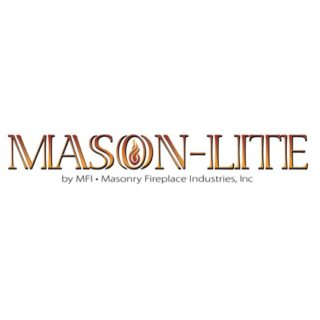How to specify custom pre-fabricated masonry
It's easier than ever to incorporate custom masonry fireplaces into projects
Incorporating custom masonry fireplaces into projects is quicker and more efficient than ever. AIA partner Mason-Lite explains what architects need to keep in mind.

The popularity of custom modular, pre-fabricated masonry fireplaces is spreading across the nation, in part because the possibilities are nearly endless and also because they can now be designed and installed quickly and inexpensively compared to traditional methods.

Innovative manufacturing processes allow for the development of custom masonry fireplaces quickly and efficiently to the exact dimensions needed. Custom fireplace design options include standard (single-sided), see-through, corner, three-sided peninsula, three-sided bay, and four-sided units. (See a sampling of some unique fireplaces here.)

Specifying custom pre-fabricated fireplaces
It is very important to know the exact size of the fireplaces you are specifying to ensure the finished product will fit your plans. Masonry fireplace manufacturers can now provide detailed specifications of units that provide the measurements and proportions you need to include in your plans. This helps you to understand the thicknesses of material and the clearances that may be required.
One of the most important dimensions to have specified properly is the chimney orientation(s). Knowing how large and how to position the chimney hole(s) on the top of the fireplaces can save costly changes later on in the project. Be sure to confirm the chimney requirements early in your fireplace design and specification process to avoid these costly changes at a critical juncture in your projects.
Chimney specification & design practices
Though there are so many possibilities when it comes to custom modular, pre-fabricated masonry fireplaces, there are a few limitations. With all fireplaces, the venting is determined by the square footage of the opening. There are documents to help determine the chimney necessary for your project (determinations made using these documents should always be confirmed by your fireplace provider).
For units with openings that are just too large to vent by standard means, multiple solutions are available to still allow for the fireplace you desire. The first option is to add a chimney fan, or multiple fans, to create the necessary draft to allow the fireplace to vent mechanically. Some scenarios will not allow for a chimney fan, either by design or homeowner preference. In these cases, there is still a way to vent the unit naturally by using fixed glass above the opening. By using fixed glass to cover some portion of the top of the opening, you allow the fireplace to function as if the opening is much shorter while still allowing for a large viewing area. Another way to use fixed glass, specifically for multisided units, is to cover one side with fixed glass while keeping the other side fully open, as shown below.

If neither of these options is acceptable, then the opening would need to be reduced to match the maximum chimney diameter and quantity of chimneys that the unit is able to accommodate. Your fireplace manufacturer should be able to walk you through the best option for your specific design and constraints.
Structural steel support for custom masonry fireplaces
Custom masonry fireplaces can range from 3- to 30-foot-wide or more linear styles to 5-foot and taller Rumford-style fireplaces. While pre-fabricated masonry fireplaces are lightweight in comparison to the traditional practices and materials used for site-built masonry fireplaces, the units do need some additional reinforcement based on the size and shape. Calculations for steel to support these units needs to be done by a local structural engineer; estimations of the weight of these fireplaces can be provided by the fireplace manufacturer. (Click here for some examples of installations that use structural steel.)
Don’t miss out on the growing trend of custom masonry fireplaces that has been sweeping the nation. Visit Mason-Lite.com/customorder to design your next custom masonry fireplaces to your specific needs.
AIA does not sponsor or endorse any enterprise, whether public or private, operated for profit. Further, no AIA officer, director, committee member, or employee, or any of its component organizations in his or her official capacity, is permitted to approve, sponsor, endorse, or do anything that may be deemed or construed to be an approval, sponsorship, or endorsement of any material of construction or any method or manner of handling, using, distributing, or dealing in any material or product.

